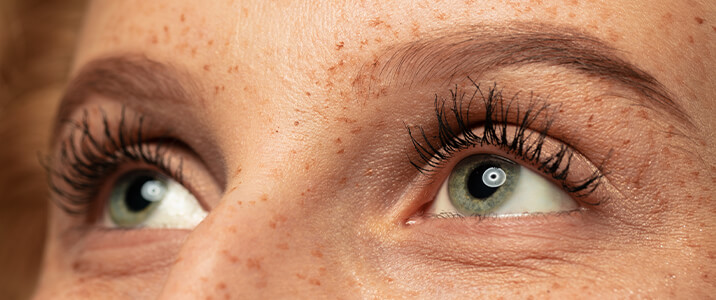LATISSE® (bimatoprost ophthalmic solution) 0.03% is the first and only science-based prescription treatment approved by the U.S. Food and Drug Administration (FDA) for hypotrichosis that is used to grow eyelashes, making them longer, thicker and darker.
Eyelash hypotrichosis is another name for having inadequate or not enough eyelashes.

How is LATISSE® used?
LATISSE® solution is a once-daily prescription treatment applied to the base of the upper eyelashes with a sterile, single-use-per-eye disposable applicator. LATISSE® should not be applied to the lower eyelashes as there is a potential for hair growth to occur in areas where LATISSE® comes in repeated contact with skin surfaces, and only the sterile applicators packaged with LATISSE® should be used to apply the treatment. Don’t allow the tip of the bottle or applicator to contact surrounding structures, fingers, or any other unintended surface in order to avoid contamination by common bacteria known to cause infections. Contact lenses should be removed prior to application of LATISSE® and may be reinserted 15 minutes following its administration.
How was LATISSE® studied?
LATISSE® solution was clinically tested in a Phase III study. Patients were randomly assigned to apply treatment with LATISSE® or vehicle to both upper eyelids, at the base of the lashes, once daily for 16 weeks. The primary efficacy endpoint was overall eyelash prominence at the end of the 16-week treatment period as endpoints were eyelash length, thickness, and darkness. All of the endpoints in the LATISSE® pivotal trial were met. By the end of the 16-week treatment period, patients treated with LATISSE® experienced statistically significant greater improvement (p < 0.0001 for each endpoint) than those in the placebo group in the measurements of eyelash prominence, length, thickness and darkness.
Does LATISSE® work?
In a Phase III clinical study, LATISSE® solution users experienced statistically significant improvements in eyelash prominence at the end of the 16-week timeframe, including:
Assessment Scale
25% increase in length of their eyelashes (vs. 2% for vehicle)
106% increase in thickness/fullness of their eyelashes (vs. 12% for vehicle)
18% increase in darkness of their eyelashes (vs. 3% for vehicle)
What are the possible side effects of LATISSE®?
The most common side effects after using LATISSE® solution are an itching sensation in the eyes and/or eye redness. This was reported in approximately 4% of patients. LATISSE® solution may cause other less common side effects which typically occur on the skin close to where LATISSE® is applied, or in the eyes.
Before and After Photo of LATISSE® Clinical Trial Patient (after is at week 16). Individual results may vary following treatment. If you stop using LATISSE®, your eyelashes are expected to return to their previous appearance over several weeks to months.
These include skin darkening, eye irritation, dryness of the eyes, and redness of the eyelids. If you develop a new ocular condition (e.g., trauma or infection), experience a sudden decrease in visual acuity, have ocular surgery, or develop any ocular reactions, particularly conjunctivitis and eyelid reactions, you should immediately seek your physician’s advice concerning the continued use of LATISSE® solution.
Are there any special warnings associated with LATISSE® use?
If you are using LUMIGAN® or other products in the same class for elevated intraocular pressure (IOP), or if you have a history of abnormal IOP, you should only use LATISSE® under the close supervision of your physician. LATISSE® use may also cause increased brown pigmentation of the colored part of the eye which is likely to be permanent. It is also possible for a difference in eyelash length, thickness, fullness, pigmentation, number of eyelash hairs, and/or direction of eyelash growth to occur between eyes. These differences, should they occur, will usually go away if you stop using LATISSE®.
How does LATISSE® work?
Although the precise mechanism of action is unknown, LATISSE® is believed to affect the growth (anagen) phase of the eyelash hair cycle in two ways: first, it increases the length of this phase; and second, it increases the number of hairs in this growth phase. Bimatoprost is the active pharmaceutical ingredient in LATISSE®.
What happens when you stop treatment with LATISSE®?
To maintain effect, continued treatment is required. If use of LATISSE® solution is discontinued, eyelashes will gradually return to where they were prior to treatment over a period of several weeks to months (average eyelash hair cycle).
Where can I purchase LATISSE®?
LATISSE® is available only by prescription, and any doctor can prescribe it. In most states, it is permissible for doctors to dispense prescription products, so consumers can purchase LATISSE® from their prescribing doctor.
Important Information About LATISSE®
LATISSE® solution is a prescription treatment for hypotrichosis used to grow eyelashes, making them longer, thicker and darker. Eyelash hypotrichosis is another name for having inadequate or not enough eyelashes.
Important Safety Information
If you are using prescription products for lowering eye pressure or have a history of eye pressure problems, only use LATISSE® under close doctor supervision.
May cause eyelid skin darkening which may be reversible, and there is a potential for increased brown iris pigmentation which is likely to be permanent.
There is a potential for hair growth to occur in areas where LATISSE® solution comes in repeated contact with skin surfaces.
If you develop or experience any eye problems or have eye surgery, consult your doctor immediately about continued use of LATISSE .
The most common side effects after using LATISSE® solution are an itching sensation in the eyes and/or eye redness.
For more safety information on LATISSE®, please refer to full prescribing information.
©2009 Allergan, Inc. 2525 Dupont Drive, Irvine, CA 92612. marks owned by Allergan, Inc.
Shop Now